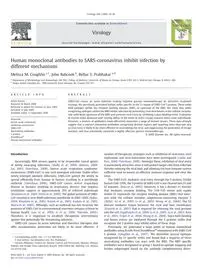
2009 Human monoclonal antibodies to SARS-coronavirus inhibit infection by different mechanisms PDF
Preview 2009 Human monoclonal antibodies to SARS-coronavirus inhibit infection by different mechanisms
Human monoclonal antibodies to SARS-coronavirus inhibit infection by different mechanisms Melissa M. Coughlin a,1, John Babcook b, Bellur S. Prabhakar a,⁎ a Department of Microbiology and Immunology (MC790), College of Medicine, University of Illinois at Chicago, Room E705. 835 S. Wolcott Ave, Chicago, IL 60612, USA b Amgen British Columbia Inc., 7990 Enterprise Street Burnaby, BC, Canada V5A 1V7 a b s t r a c t a r t i c l e i n f o Article history: Received 26 March 2009 Returned to author for revision 22 June 2009 Accepted 15 July 2009 Available online 12 September 2009 Keywords: Severe acute respiratory syndrome-coronavirus SARS-CoV Neutralizing antibodies S protein XenoMouse® Human monoclonal antibodies SARS-CoV causes an acute infection making targeted passive immunotherapy an attractive treatment strategy. We previously generated human mAbs specific to the S1 region of SARS-CoV S protein. These mAbs bind epitopes within the receptor binding domain (RBD) or upstream of the RBD. We show that mAbs recognizing epitopes within the RBD inhibit infection by preventing viral attachment to the cellular receptor. One mAb binds upstream of the RBD and prevents viral entry by inhibiting a post-binding event. Evaluation of several mAbs demonstrated varying ability of the mAbs to select escape mutants when used individually. However, a mixture of antibodies could effectively neutralize a range of mutant viruses. These data strongly suggest that a mixture containing antibodies recognizing distinct regions and targeting more than one step in viral entry is likely to be more effective in neutralizing the virus and suppressing the generation of escape mutants, and thus potentially constitute a highly effective passive immunotherapy. © 2009 Elsevier Inc. All rights reserved. Introduction Increasingly, RNA viruses appear to be responsible causal agents of newly emerging infections (Duffy et al., 2008; Holmes, 2004; Lai, 2003; Osterhaus, 2008). Severe acute respiratory syndrome- coronavirus (SARS-CoV) is one such emergent infection. Unlike other newly emerged zoonotic infections, SARS-CoV gained the ability to spread efficiently from human to human resulting in a worldwide outbreak (Osterhaus 2008). SARS-CoV causes severe respiratory disease in humans resulting in respiratory distress that requires ventilation support in approximately 20% of infected individuals (Knudsen et al., 2003; Peiris et al., 2004). The global outbreak of SARS- CoV resulted in over 8000 infections worldwide in 2002–2003 (Baker, 2004; Knudsen et al., 2003; Ksizek et al., 2003; Kuiken et al., 2003; Marra et al., 2003). Although, such an outbreak has not recurred, the presence of SARS-CoV in environmental reservoirs remains a threat to human health (Lau et al., 2005; Li et al., 2005; Normile, 2005). Therefore, it is important to establish therapeutic interventions against this potentially life threatening infection. SARS-CoV causes an acute infection and therefore therapies that offer instantaneous protection are likely to be most effective. A number of therapeutic strategies such as inhibition of viral entry, viral replication, and viral maturation have been investigated (Golda and Pyrc, 2008; Osterhaus, 2008). Amongst these, inhibition of viral entry is particularly attractive since it will protect target cells from infection thereby reducing the viral load, and allowing the host immune system sufficient time to mount an effective immune response and clear the virus. The SARS-CoV, mediates viral entry through the S protein. Unlike human CoV-229E, the S protein of SARS-CoV is not cleaved into S1 and S2 domains (Rota et al., 2003). However, it has a distinct S1 domain that mediates receptor binding. The 318–510 amino acid region within S1 represents the receptor binding domain (RBD) that inter- acts with the cellular receptor, angiotensin-converting enzyme 2 (ACE2) (Li et al., 2005; Li et al., 2003; Wong et al., 2004). The S2 domain mediates fusion between the viral and host membranes (Ksiazek et al., 2003) that is required for releasing the viral genome into the cell (Ingallinella et al., 2004; Li et al., 2005; Li et al., 2003; Rota et al., 2003; Tripet et al., 2004; Wong et al., 2004). Since both binding and fusion events are mediated through the S protein, mAbs that recognize the S protein may inhibit either of these steps. Previously, we generated a large panel of human monoclonal antibodies using B cells from XenoMouse® immunized with SARS-CoV S protein (Coughlin et al., 2007). We identified several epitopes recognized by S1 specific mAbs and found that a majority of these neutralizing antibodies can react with the RBD. The RBD specific antibodies were designated as group 1 based on epitope mapping and further subgrouped based on the antibody complementary deter- Virology 394 (2009) 39–46 ⁎ Corresponding author. Fax: +1 312 996 6415. E-mail address:
